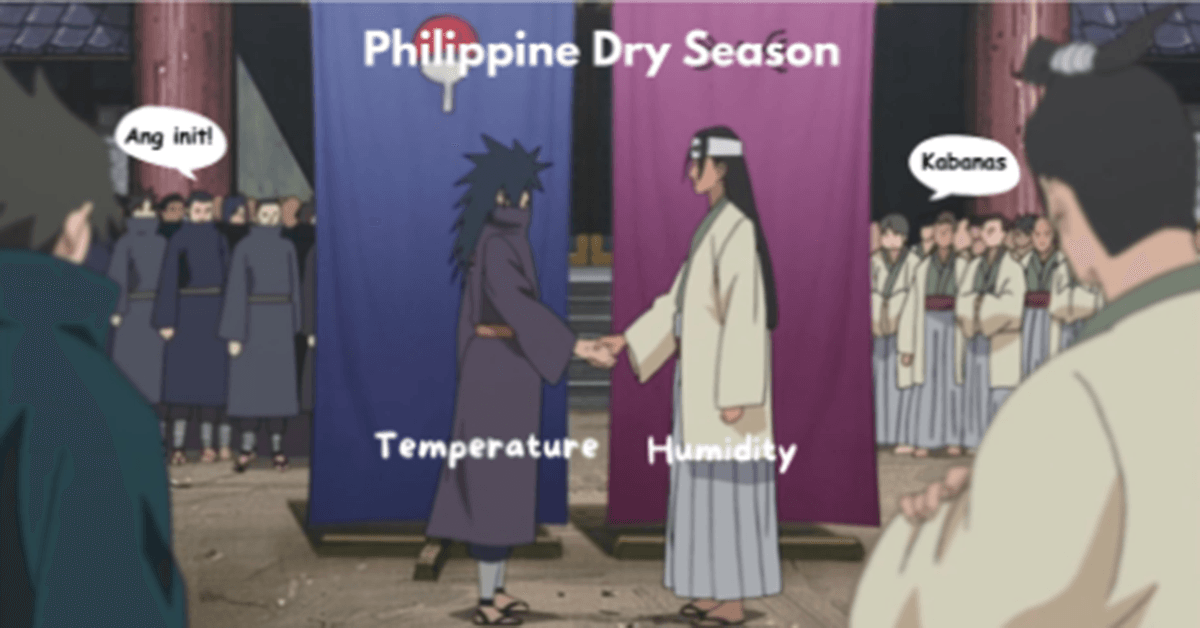We’ve finally (really, finally?!) unveiled another season of our lives, literally!
As the calendar rips itself, marking the reigning month of the sun, it signifies two things: fun and sweat. Where people are either at the beach, having the best days of their lives while diving into the vast space of the ocean, or at their own houses, wiping the sweat caused by the extreme heat while saying the cliché expression of this season, “Ang init”. Cruel summer, isn’t it?
It’s warm and dry season again! Or ‘summer’ as what the Filipinos often refer to even though technically, according to Philippine Atmospheric, Geophysical, and Astronomical Services Administration (PAGASA), the Philippines has only two seasons: the rainy and dry seasons. The former starts from June to November while the latter starts from December to May. However, as of now, the country is experiencing a hot dry season, which is evident to the current status of the climate.
The weather tells us that the idea that was proposed by a Greek philosopher named Heraclitus about change being a constant variable of time was true. But the question of how far can this change be evident to modern times is really a tricky one. With a lot going on at the moment, Heraclitus may also be referring to climate change.
Ang Init: Unveiling The Country’s Dry Season
Seasons play an important role in the dynamic life of an individual. From their emotional health, rhythmic lifestyle, and behavioral aspects. Every activity may depend on the environment it is based on. For instance, during this dry season, Filipinos most often go to beaches and pools to relieve the warmth they’re experiencing. Basically, we adapt to survive, as per what Charles Darwin has said.
Currently, as the country experiences a tremendous hotness in their surroundings, it’s not only the temperature that contributes to this. There are three main factors that greatly affect a country’s weather and climate. It includes temperature, humidity, and rainfall.
But looking back, how does temperature differ from humidity? And what about the heat index? What is it?
Temperature vs. Heat Index
As similar as it may sound, temperature and heat index are two completely different things — they are not twins in any way possible but they are related to each other. You may often hear statements such as, “Ang init ng temperatura,” or “Kabanas (Kainit) naman,” which relates to the two.
In addition, the story of the country’s dry season is not only narrated and affected by the temperature alone. There comes the other character, humidity, which will help us get to know the difference between the two.
Humidity, in general, is the amount of water vapor in the atmosphere. And when humidity combines with the air temperature, which is the climate’s atmospheric changes determined by hot or cold weather, the result is what we call heat index or ‘apparent temperature’. In addition, heat index is the feeling of hotness perceived by the body which reduces an individual’s system to cool itself.
To exemplify, PAGASA recorded on April 4, 2024 a whooping temperature of 38.4°C in Tugegarao City, Cagayan. However, with a humidity of 49%, the heat index jumped to 44°C — which PAGASA considered as part of the danger category due to its high apparent temperature.
To simply put, the temperature that an individual feels is the heat index, which is the combination of air temperature and relative humidity in the atmosphere. Thus, there is a direct relationship between the temperature and heat index. To illustrate, as the air temperature increases, the heat index also increases, and vice versa. The severe heat that a place experiences is not only the temperature itself but other factors affecting it as well.

Therefore, the heat index is different from the air temperature. Whereas, it is, technically, the sum of temperature and humidity when combined.
Philippines’ Heat Index in a Nutshell
The interplay and correlation between temperature and heat index has greatly affected the summer experiences of the Filipinos. As the calendar flips its page to March, it is not unknown to us how the country’s heat index will become active again once the dry season starts. Some places in the Philippines experience an extreme heat index where it even reaches to 40°C — which is too much and too hot, especially for the places with a low number of trees.
According to PAGASA, as of April 15, 2024, Dagupan City, Pangasinan has reached a 47°C heat index which can be considered as an extreme one. Given that the country also resides near the equator where the tropical countries receive more sunlight during this season causing its temperature to rise, many places in the country have also experienced such high heat index which causes a lot of issues in different sectors.
Here are also the places in the Philippines that experienced the extreme caution to danger heat index as of April 15, 2024:
- Dagupan City, Pangasinan – 47°C
- Cavite City, 45 °C
- Aborlan, Palawan – 44 °C
- Baler, Aurora – 44 °C
- Iloilo City – 44 °C
- CBSUA, Pili, Camarines Sur – 43 °C
- Casiguran, Aurora – 42 °C
- Davao City, Davao del Sur – 42 °C

On the other hand, PAGASA reiterated in a statement that the country will experience this extreme heat index in some places. “In the coming months, warmer temperatures are expected, and rainfall across the country will be influenced mostly by easterlies and localized thunderstorms,” the agency said.
The dynamic changes in the Philippines’ weather and climate are one of the manifestations that change is inevitable and so is climate change. Thus, as there’s little to none changes on human behavior towards the environment, this change will continue and will affect people in the country. And with that, we’ll continue to witness the Philippines’ heat index in a nutshell for the next succeeding months.
Kabanas Ah!: What To Do With The Summer Heat
As the new season unveils, new tactics and strategies are needed to adapt with this ever-changing extreme high index. This affects our health thus, every individual should be equipped with knowledge as to how they can lessen the effects of extreme heat to their system.
In addition, this can also help everyone to enjoy this new season and make the best out of it instead of constantly saying, “Kabanas ah”. It’s either dive to fun or sweat to no fun.
Get To Know: Heat Index Classifications
Heat index, also known as apparent temperature or ‘damang init’, has four categories; each showing the level of heat stress and the corresponding safety measures advised in hot and humid weather. In addition, each classification corresponds to a certain range of heat index with its possible effects to an individual.

(Photo)
- Caution (27-32°C) – In this category, it imposes minimal possibility of getting fatigue or heat cramps.
- Extreme caution (32-41°C) – It increases possible effects of heat index like heat cramps and heat stroke especially to the vulnerable ones such as the elderly and children.
- Danger (41-54°C) – Heat cramps and heat stroke are possible in this category especially for those people that are exposed to prolonged heat outdoors.
- Extreme Danger (54°C and above) – In this classification, heat stroke and other effects of extreme heat index is very likely.
In these times where heat is active, safety precautions to avoid its effect is highly encouraged, especially those who are vulnerable to heat. In addition, by knowing such, we can prevent its damage to our health as well as we can be prepared for its unprecedented changes.
Currently, the highest heat index recorded in the country was on Casiguran, Aurora that reached 60°C on August 14, 2023 which is classified by the PAGASA as an extreme danger category.
Beat the Heat: Cope Up With It
Furthermore, the Department of Health (DOH) has recommended tips on how to minimize the effects of the extreme heat index on one’s system. To continue the fun this summer, it is important to look out for the effects and avoid it as much as you can.
Here are some tips you can do to avoid heat stroke and other heat-related effects:
- Drink plenty amount of water to avoid dehydration;
- Avoid prolonged exposure to heat;
- Dress in lightweight;
- Limit outdoor activities as much as possible;
- Avoid caffeinated and alcoholic beverages; and
- Take breaks at shady and cool areas.

(Photo)
Furthermore, the DOH also warned the public to look out for the signs and symptoms of heat exhaustion and heat stroke so that it can be mitigated and handled as soon as possible before it escalates further.

(Photo)
As the sun casts its rays onto the land, it is timely to mind the different safety precautions to keep yourself safe from the summer heat so that we can be able to beat it.
Furthermore, if such cases where an individual experienced a heat stroke, don’t panic and do the following:
- Put the person in a shady area;
- Apply ice compresses;
- Put cold wet cloth on the person’s armpit, ankles, and groin;
- If the person is conscious, let him sip an amount of water; and
- Bring him to a hospital immediately

(Photo)
Moreover, PAGASA continued to remind everyone to stay cautious at this time to prevent the possible effects of the extreme heat index. As the fun and scorching heat collides, the agency also reminded the public to limit activities and focus on the true essence of this season.
Ka-Pawis Na: To Conclude
This season, truly, signifies two things: fun and sweat. However, it also reminds us that we must act according to it. That the ever-changing weather brought by the global warming of the planet tells us that the sweat we secrete might have been triggered by our behaviors. Cruel summer, isn’t it?
The ongoing battle on climate change that the Earth is currently experiencing might also be the manifestation of the consequences of the long overdue activities of the people that contributed to global warming. That everything, including the extreme heat index, was caused by humans themselves.
As time goes by, some people still call the sun cruel, however, some didn’t realize that they were being the one cruel to the planet serving them home. That’s why whenever we jump into the vast space of the oceans or wipe the sweat off our forehead, realizations must come first before complaining and blaming something.
On the other hand, no matter how init, or kabanas, or kapawis it is, always make sure to limit everything and make the most out of it. Bring out the fun in thee while being mindful of what we’re doing.
Onto the next season, literally!
Infographics by Marcus Radovan/AMAPS




There are no comments yet. Add your comment to start the conversation.